All photos courtesy of Uncornered Market.
Over the last two and a half decades, the combined mountain gorilla population of Uganda, Rwanda, and the Congo has increased to almost 900 from 620. What impact, if any, has responsible tourism had on this upswing? We offer a few thoughts and tips that draw from our own mountain gorilla-trekking experience in Uganda.
“If the gorillas come out of the forest and cross the stream, the unofficial border with the village, the villagers know to call us — the National Park — to get the gorillas off their land,” our gorilla-trekking guide explained to us. “They know now not to hurt the gorillas. If the gorillas destroy crops, we compensate the villagers. We have a good relationship with the community now.”
These are the rules of gorilla engagement in Uganda. But it wasn’t always so.
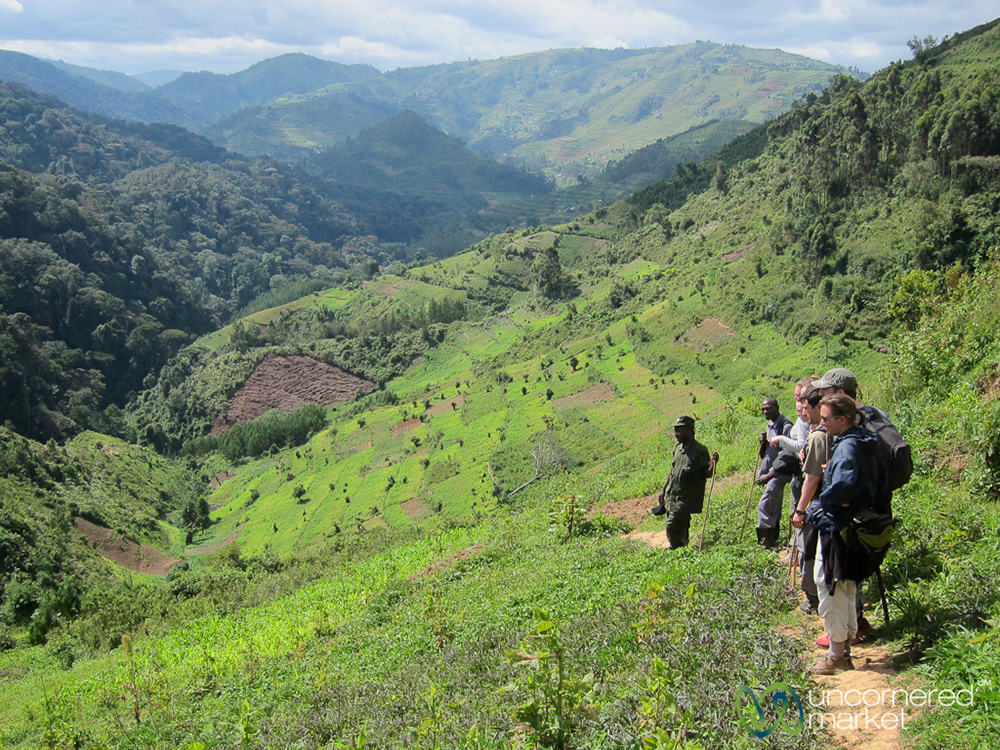
Village farmlands on the edge of the Bwindi Impenetrable National Park, Uganda.
We’d just walked through fields of crops next to a village en route to the edge of the forest in Bwindi Impenetrable National Park, Uganda. No barrier or physical border exists between the world of the mountain gorillas and that of the local villagers trying to make a living from the land in this lush region. Meeting the needs of both gorillas and villagers is a delicate balancing act. In her work with chimpanzees and other primates, Dr. Jane Goodall discovered that “when we put local communities at the heart of conservation, we improve the lives of people, animals, and the environment.” With its strict rules for travellers who partake in mountain gorilla trekking in Uganda, that is what the Bwindi Impenetrable National Park aims to do.
How responsible tourism reconciles the intersection of gorilla populations and human development
According to the World Wildlife Fund For Nature and African Wildlife Federation, the main threats to mountain gorilla populations include hunting or poaching, habitat loss due to deforestation and agricultural development, and the pursuit and extraction of natural resources in gorilla habitats. Mountain gorilla populations face challenges in each of the three countries where the animals reside, including Uganda, where around 400 mountain gorillas live in the Bwindi Impenetrable National Park.
In Uganda, the growth of mountain gorilla trekking and tourism has helped protect gorillas through a transparent, multi-step process. As the government receives funding for conservation, it makes an effort to develop policy and processes to protect the animals and their habitat. There is significant economic benefit — for individual locals and the country at large — to protecting the gorillas and the forest national park they call home. The fees travellers pay for gorilla-trekking permits not only help fund staff that patrol the forest and protect gorillas from poachers and hunters, but they also help fund education and development in communities that border the gorilla habitat.
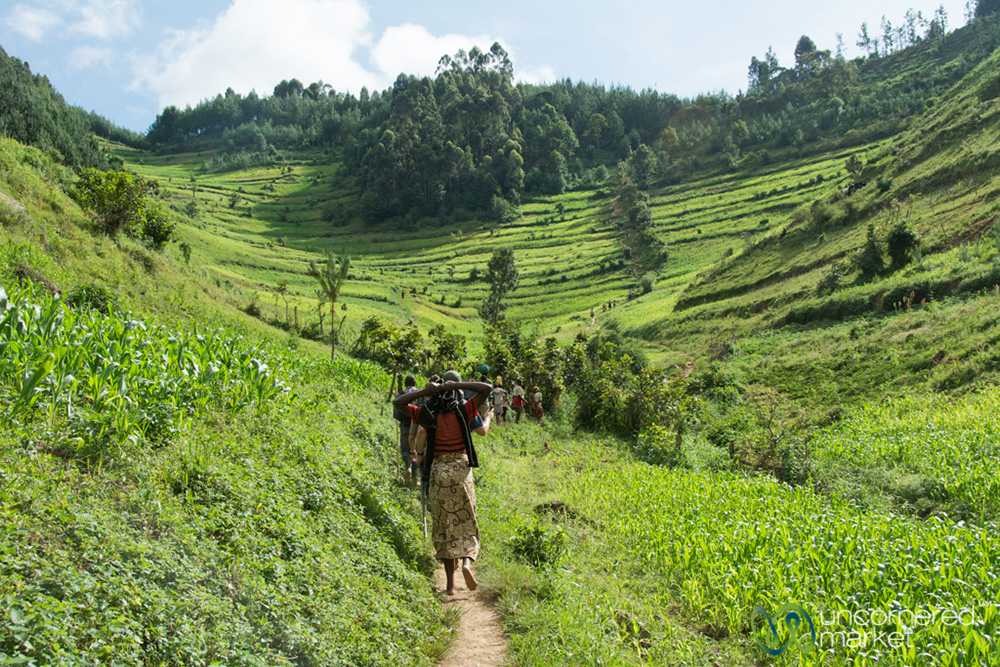
Walking with local villagers through the fields to reach the forest that gorillas call home.
This sort of relationship underscores an oft-missing component of conservation schemes. Without the engagement and cooperation of locals, preservation schemes are destined to fail. On the flip side, when residents see conservation initiatives as a win-win for themselves and for the environment, such initiatives can be truly sustainable.
This systemic approach to the needs of all stakeholders aligns with Dr. Goodall’s philosophy that “human needs must be addressed in order to achieve durable protection for the natural world.”
In the case of Uganda’s gorilla trekking, there is the economic motivation through tourism to protect the gorillas and their habitat from encroaching on local land development and farms, and vice versa. This is done partly by distributing part of the park fees to local communities, compensating for destroyed crops, and providing for environmental education.
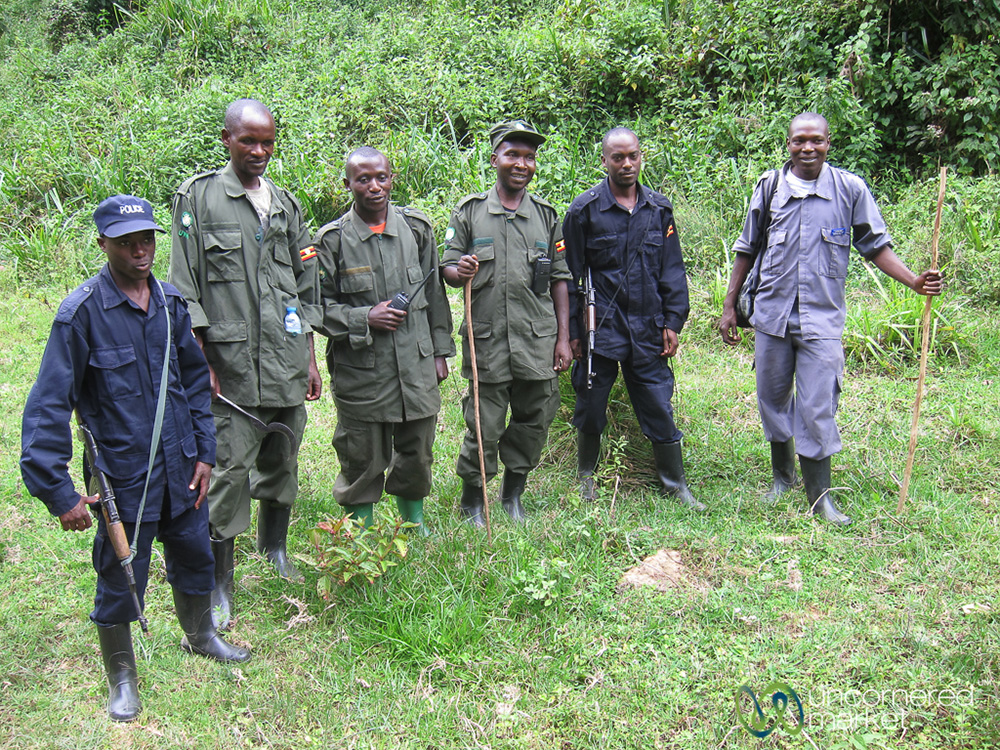
Our support team for gorilla trekking, including a lead guide, scouts, trackers, and a porter.
There are also employment opportunities at Bwindi Impenetrable National Park, where locals can learn to work as gorilla-trekking guides, trackers, and scouts. In addition, with increased tourism traffic, there’s also an increase in economic activity and local employment in hotels, restaurants, and other area service providers. The economic ripples set off through a tourism product based on conservation are not only clear in theory, but also in the practice and real life of the local people who live nearby.
The ultimate upshot is that, thanks to tourism done right, a live gorilla is now worth much more than a dead one, and as a result, locals are much less likely to engage in hunting and poaching. The impact to the future of tourism, the health of local gorilla populations, and to local human communities is profound.
Respectful encounters with mountain gorillas
The bureaucracy and high fees surrounding mountain gorilla-trekking permits help limit the number of people each day at the national park, which thereby limits the daily exposure of the mountain gorillas to eager, camera-toting tourists. The entire process intends to preserve the “wildness” of the gorillas while maintaining an ample revenue stream from a sufficient number of travellers who pay for a gorilla encounter.
In order to manage this, each group of travellers is assigned to a different gorilla family, so as to avoid overwhelming any one family. The group is allowed one hour maximum with the gorilla family and is required to keep a safe and respectful distance. In addition, the National Park facilitates a pre-trek workshop that helps visitors understand how important the protection of mountain gorillas is to the greater ecosystem.
Our experience with mountain gorillas in Uganda
During our mountain gorilla-trek in Uganda, the necessary coordination behind the scenes between guide, trackers, and scouts was clear. Trackers set out in the early morning to track the gorilla family so that, by the time we began our walk, the trackers had located them having their breakfast not too far from the forest’s edge.
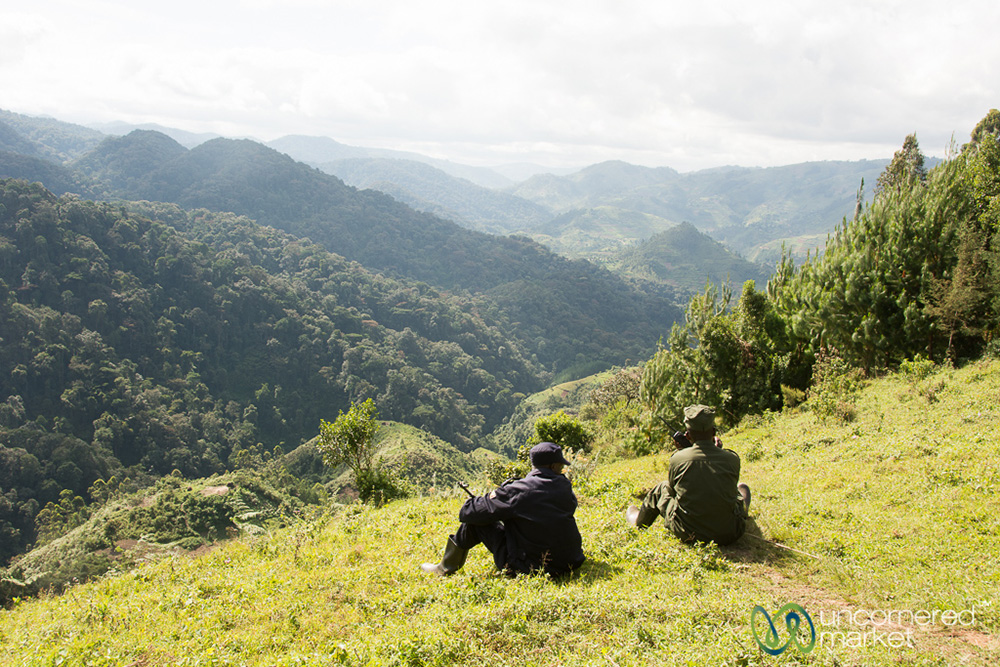
Our guide and one of the scouts wait for word over the radio from a tracker in the forest as to the location of the gorilla family.
How long it takes travellers to locate their assigned gorilla family varies. It only took us about 30 minutes, while other groups out the same day took more than three hours to find theirs. We spoke with others who spent six hours searching. That’s the nature of wild animal encounters — there’s no schedule or guarantee, so expectation management is crucial.
Forest trekking can also take time, with the lush, humid, and damp environment offering no clear paths. We sometimes had to pull ourselves up steep jungle grades by grasping onto branches, plant roots, and bushes. After all, this terrain is made for mountain gorillas, not humans.
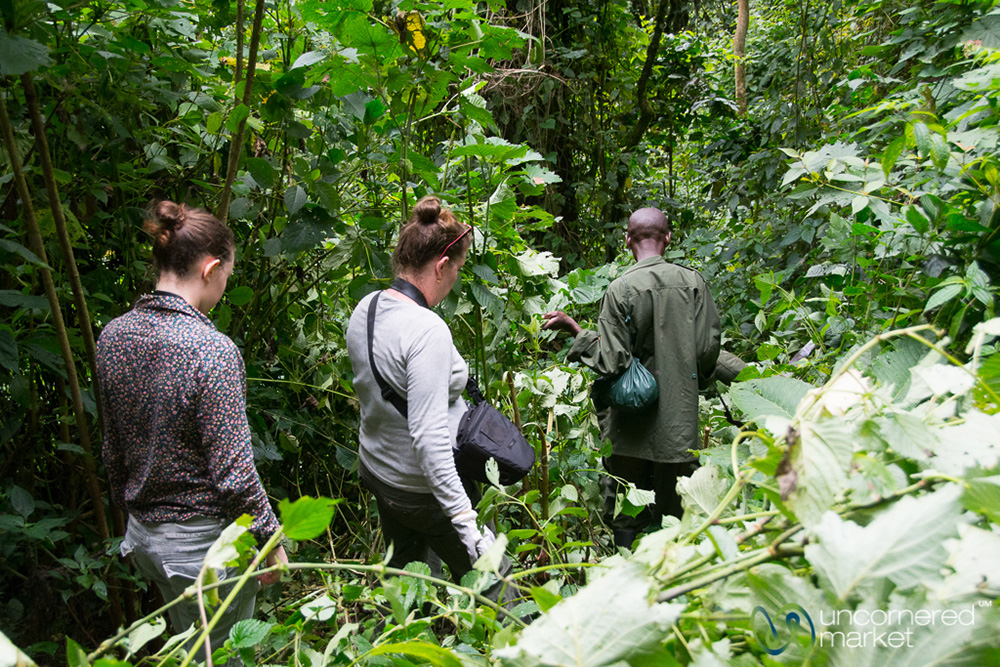
Following the trackers through the thick forest to find the gorillas.
Once we neared the gorilla family, our guides silently motioned they were close, and we began to move more slowly and quietly. Despite knowing the family was nearby, we were still shocked to take a turn and come face to face — literally — with a giant male silverback. His calm, deliberate movements belied his size and strength. He ate slowly, watching us as we watched him.
This behaviour, though simple, is stunning. It’s hard not to be mesmerized by your first encounter: you lock eyes for a brief moment, and there’s an undeniable feeling of connection.
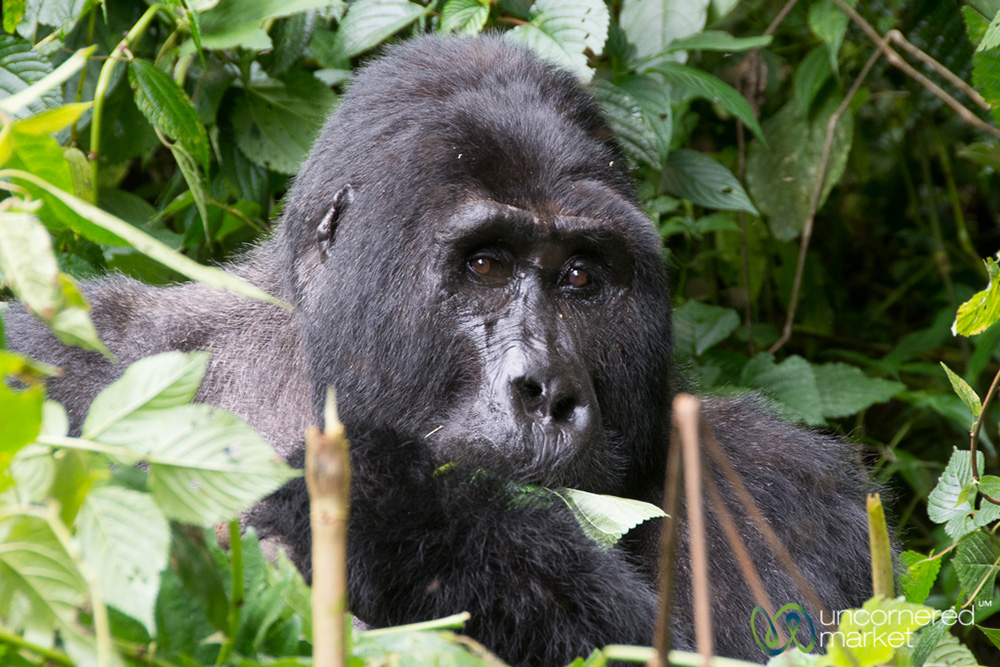
Turning the corner and coming face to face with a large silverback gorilla is awesome in the truest sense of the word.
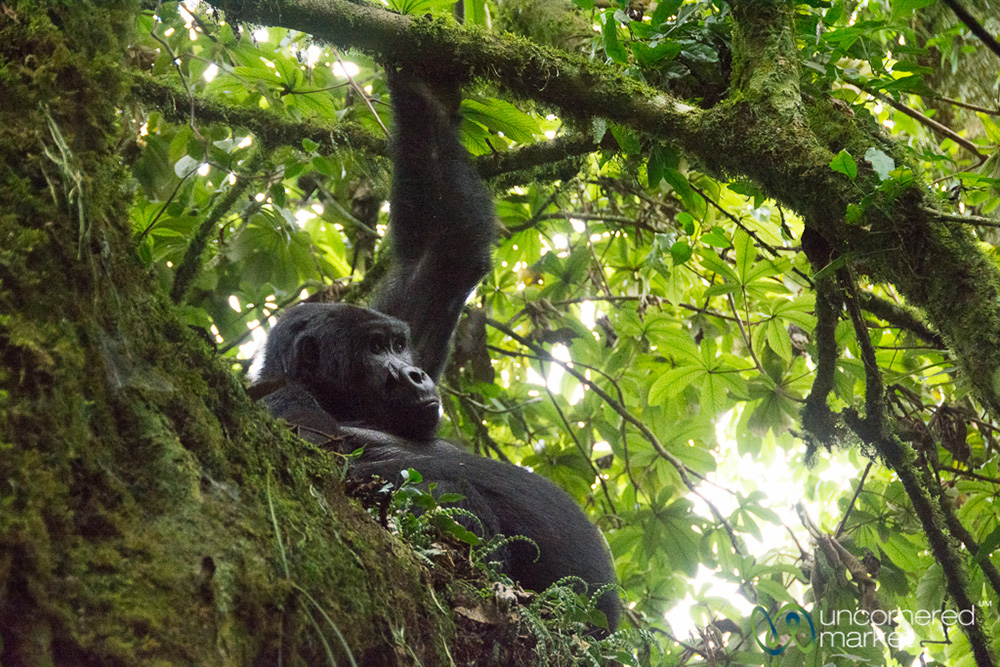
A teenaged gorilla hanging out in a tree above us.
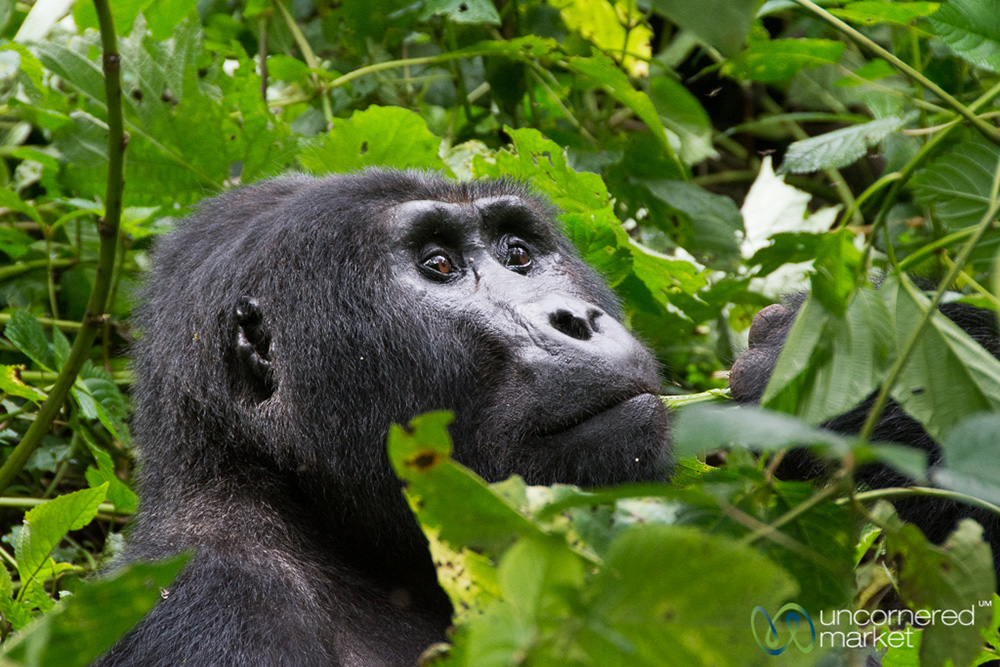
We bid farewell to the silverback after an hour together.
It’s true that visits from humans are an unnatural encounter for these gorilla families — imagine a bunch of photographers and visitors entering your home for an hour each day. But, as stated earlier, the gorilla treks in Uganda provide motivation and funding to protect the gorillas themselves, and their habitat. The experience is not only about the moments each group of travellers spends in the presence of these wild animals. it is also about how travellers play a role in the sustainable conservation efforts for these mountain gorillas.
Getting there
See Uganda on a Jane Goodall Collection by G Adventures tour. This selection of 20 of our incredible, wildlife-focused tours endorsed by world-renowned primatologist Dr. Jane Goodall has been designed to bring you into close contact with our planet’s most fascinating creatures in a manner that respects their freedom. Let this collection of adventures introduce you to the world in ways you’ve never imagined.























